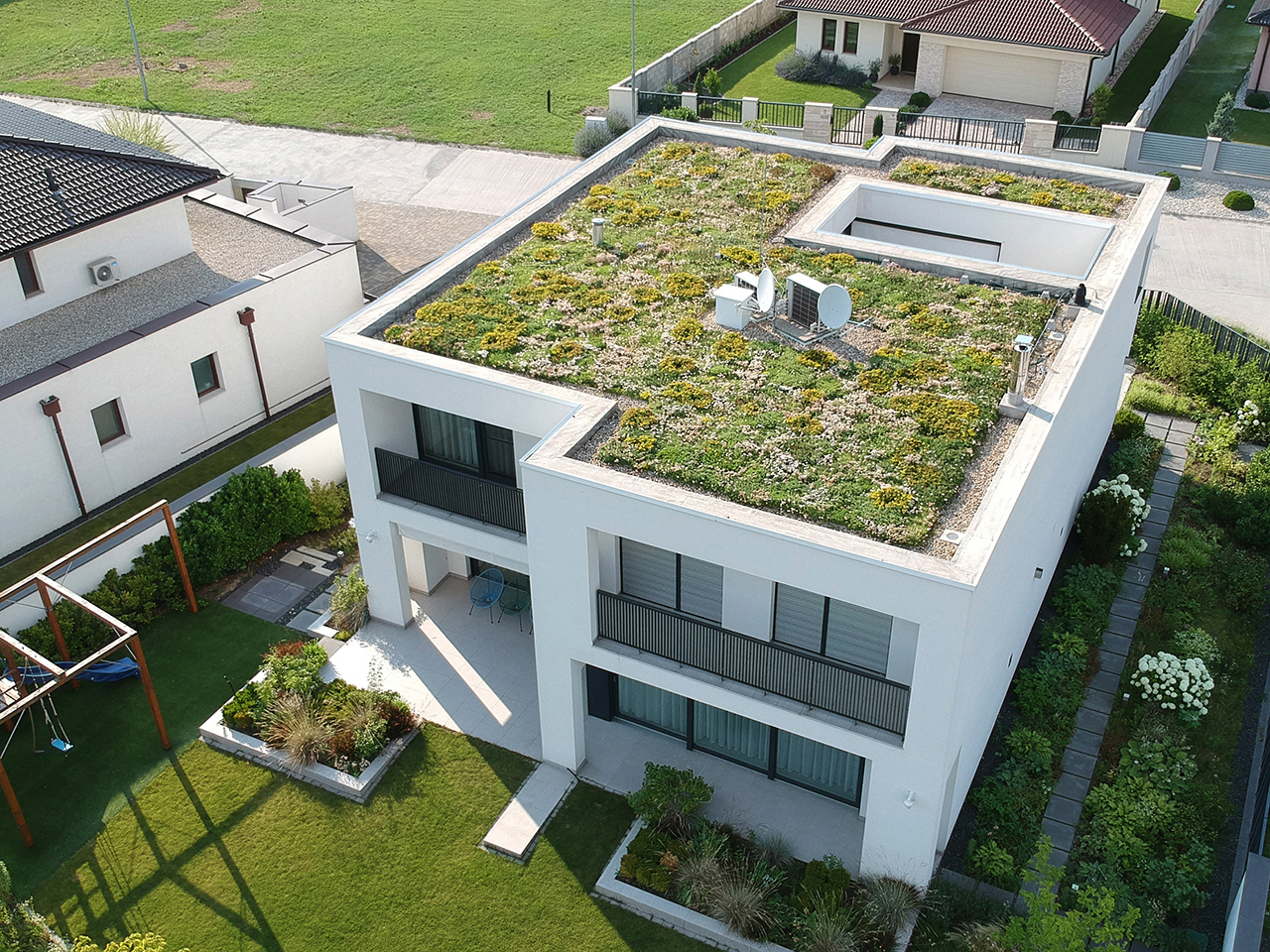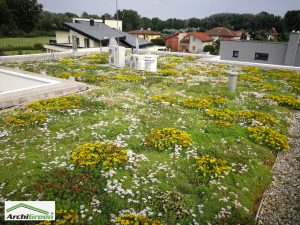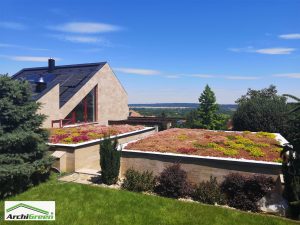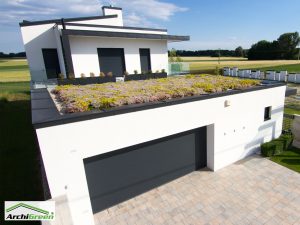
Vanishing fad or a sustainable built meant to last
Extensive rooftops on private residences
Over the past two decades, more and more green roofs have been built around the world. In fact, in some parts of the world it has even become mandatory to have a green roof on all newly established flat rooftops. Perhaps, there is more to this than just mere coincidence. However, is it just a vanishing fad? Absolutely not! Conscious thinking, and some commitment to nature to improve our well-being in both a narrower and a broader context are the key in understanding the importance of extensive green roofs, why we need more of them and why they are here to last.
Along with the advent of flat and low-pitched roofs in contemporary architecture, new ideas and technical solutions were introduced in the public domain. Roof tiles were replaced by bitumen, plastic or rubber (which suffer from poor resistance to UV rays) that required to be buried under some sort of layer due to their unpleasant appearance. Things like gravel or crushed brick maybe suitable to fulfil this task at first sight but with no added advantage. In contrast, the installation of an extensive green roof with a layer thickness of 120 mm does come with added benefits. It protects the waterproofing, significantly increases the comfort levels of the residents (especially during summer as it allows for more pleasant domestic environment) and we even get the chance to return some of that enormous human footprint to nature.

A green roof is a roof of a building that is partially or completely covered with vegetation planted over a waterproofing sealed rooftop, where the structure of the rooftop, the roofing insulation layers and the vegetation are all designed to form a harmonised well-structured unit. Two types of green roofs exist in general: The more common one is the extensive green roofs with a build-up depth of 120 – 150 mm. This type requires low maintenance. The other type is known as intensive roof gardens which provide a complete gardening experience in the skies. Even in Hungary, extensive green roofs are the more common type as more and more of this meadow-effect ecological covers are installed on family house rooftops. Their widespread is probably due to being the less expensive between the two types to establish and to maintain. Therefore, we will take a closer look at this type of green roof in our current article. Extensive green roofs or meadow roofs as some like to call them, can be installed on an existing or newly constructed roof, provided that the waterproofing is root-resistant and that the deck is structurally sound to bear an additional load of 120-150 kg/m2.
For the proper performance of an extensive green roof, one has to keep the following in mind:
– Replacement of the engineered growing medium (substrate) specifically designed to be used in green roof build-ups with conventional gardening topsoil or excess soil from construction activities can lead to a huge fiasco after the initial unfolding moments of success. This terrible replacement leads to persistent weed issues on a grand scale in the long-run and the death of the vegetation eventually due to the clogging of the fabric layers in the build-up and bad water drainage properties.
– Good practice dictates that rainwater outlets and overflows are kept clear and free of any obstruction on extensive green roofs. Sedum plants virtually withstand all harsh conditions on green roofs except being locked up in stagnant water. Therefore, inspection chambers must be installed to allow for easy inspection and quick maintenance of the outlets.
– The required gravel border around the perimeter is achieved by means of separating the planted area by using the SP separation profiles / gravel stops. These stops or boards also prevent the engineered growing media from mixing with the gravel thus maintaining a neat landscape. The boards also prevent the spread of the plants into the gravel border, thereby keeping maintenance to a minimum.
Perhaps one of one of the most attractive features of extensive green roofs is that they require low maintenance. For this purpose, we need to look for plants that once established, thrive in direct sunlight, are drought resistant, extremely sturdy and consequently require only minimal maintenance limited to occasional weeding. Sedum species fit the above well. Sedum is a perennial plant with thick, succulent leaves, fleshy stems, and clusters of star-shaped flowers. It thrives under the harshest of conditions where most other plants would die in weeks or even days. Low-growing sedum spreads along the ground reaching 100 – 150 mm in height. This makes them perfect for coverage on living roofs. As with other succulents, they are drought-tolerant and low-maintenance. In late spring and summer, star-shaped white, bright yellow and pink flowers blanket the evergreen leaves and attract butterflies. Once autumn arrives, the leaves turn burgundy and stay that way throughout the winter. Not only their colour but their height is also subject to seasonal change which has to do with their physiological activity. Succulents need more water in spring, when they are actively growing, and very little in winter. Consequently, during summer they can reach 100 – 150 mm in height to retain as much water as possible while in winter they will become smaller reaching only 20 – 50 mm in height as they prepare themselves to withstand the coming winter frosts.


The maintenance of an extensive green roof can be divided to two well defined stages. During the summer seasons of the initial two years, green roofs require watering in times of drought. As a result, weeds may appear on the roof that need to be removed which implies more maintenance at this stage. After sedum on an extensive green roof reaches a coverage of 70 % it will survive the drier periods as well. Following this period, maintenance tasks for the most part will comprise removing the weed and any other plants from the gravel strip or from any other areas where they are not supposed to be there. Weeding is then reduced to two times a year, which is worth planning for a week or two after a heavy rain in spring or in late autumn.






 Only 0.63% of companies have an AAA rating.
Only 0.63% of companies have an AAA rating.